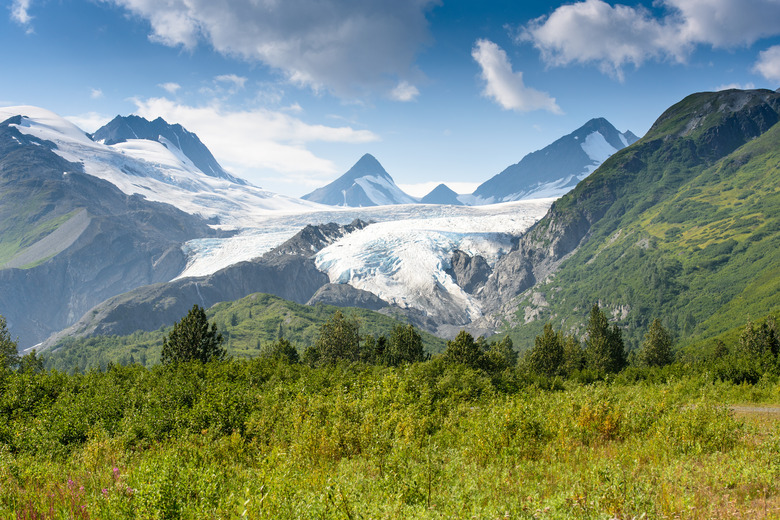Abiotic Factors Of The Alaskan Tundra
Life in the Alaskan tundra biome is filled with challenges for the plants and animals that live there. The biodiversity of these habitats is low, but tundra makes up about 20 percent of the Earth's surface. That's one-fifth of our planet's land! Though the landscape may look barren at first glance, it is full of vibrant life that has found a way to survive even in such a demanding environment.
What Is a Tundra Biome?
What Is a Tundra Biome?
The tundra is a northern, treeless landscape with short growing seasons, cold soils and air temperatures, and little precipitation. The cold weather and lack of rain and snow mean that only the smallest hardy plants and well-adapted animals are able to live here. Grizzly bears, caribou, golden eagles, bees, marmots, willows, grasses and berries are just a few of the organisms that thrive in this landscape.
Alaskan tundra can be found in the high northern latitudes (arctic or lowland tundra) as well as on top of high mountains (alpine tundra). Non-living things in the tundra have a significant effect on how living things survive. What types of tundra abiotic factors affect life here?
Read more about tundra biomes and abiotic factors.
Dry Climate
Dry Climate
The Alaskan tundra is often called a "cold desert." In Utqiagvik (formerly known as Barrow, which was renamed in 2016), on the tundra-covered coastal plain north of the Brooks Range, annual average precipitation is 4 inches. However, because of permafrost, or ground that is continuously frozen for two years or more, water is able to collect and sit near the surface of the soil. This creates moist, spongy tundra and wetlands.
How would a dry climate affect the plants that live in the tundra? Less water means less overall growth, which is part of the reason there are no trees in the tundra. Luckily, when permafrost holds water close to the surface, many of the smaller Arctic plants and shrubs are able to get the water they need to live.
Cold Temperatures
Cold Temperatures
While winter can be an extremely cold season in the tundra, it is the average cold temperatures that have the most impact on life. Average temperatures can be -30 to 20 degrees Fahrenheit (-34 to -6 degrees Celsius). Year-round coolness helps form permafrost and also limits plant growth.
High Winds
High Winds
Temperatures over the ocean near Alaska can be very different from on land, and this disparity can cause breezes that rush over the land. Without trees, the plants and animals that live on the tundra are exposed to the elements of the wind. The wind can be dry and cold, and it can carry debris that will destroy plant or animal tissue.
Short Growing Season
Short Growing Season
All of these factors lead to a shorter-than-average growing season: low precipitation, cold temperatures and lack of sunlight. In the winter, the Northern Hemisphere is tilted away from the sun, so organisms living in Alaska receive less solar energy over the course of the season. In the summer, the Northern Hemisphere is tilted towards the sun, but the sunlight hits Earth at a very low angle.
The solar energy has to travel through more atmosphere to reach the land, which means less energy is available overall. In some places on the Alaskan tundra, the growing season is just 50-60 days. Just imagine how challenging it would be to be productive in such a short amount of time!
People in the Tundra
People in the Tundra
While you may not want to live in the tundra, humans have lived and thrived in the Alaskan tundra for thousands of years. Today, Alaska Natives still live throughout the state, as well as descendants of western explorers. Many people work on oil rigs, in mines and on national lands, which has led to increased road construction and development of the tundra in the last 50 years.
References
- University of California Museum of Paleontology: The World's Biomes: The Tundra Biome
- Alaska Department of Fish and Game: Tundra
- Blue Planet Biomes: Tundra Biome
- State of Alaska: Featured Species-Associated Tundra Habitats: Arctic, Alpine and Maritime Tundra
- National Geographic: Tundras, Explained
- NPR: Barrow, Alaska, Changes Its Name Back to Its Original 'Utqiagvik'
Cite This Article
MLA
Taylor, Lindsey. "Abiotic Factors Of The Alaskan Tundra" sciencing.com, https://www.sciencing.com/abiotic-factors-alaskan-tundra-8199571/. 22 November 2019.
APA
Taylor, Lindsey. (2019, November 22). Abiotic Factors Of The Alaskan Tundra. sciencing.com. Retrieved from https://www.sciencing.com/abiotic-factors-alaskan-tundra-8199571/
Chicago
Taylor, Lindsey. Abiotic Factors Of The Alaskan Tundra last modified March 24, 2022. https://www.sciencing.com/abiotic-factors-alaskan-tundra-8199571/
